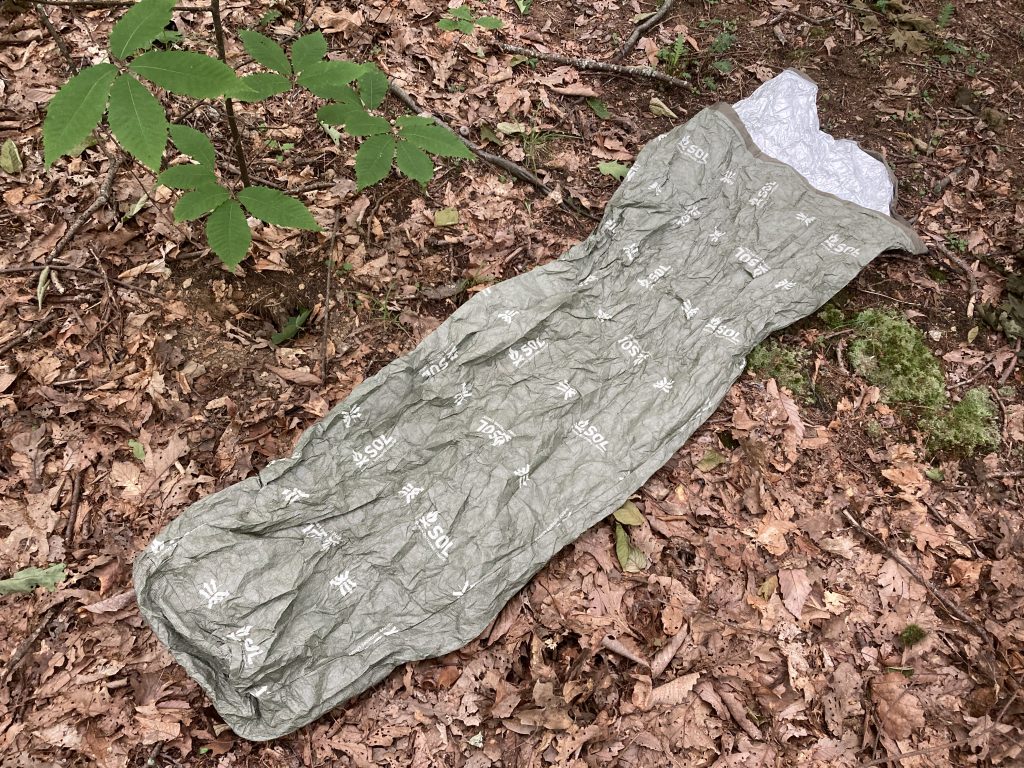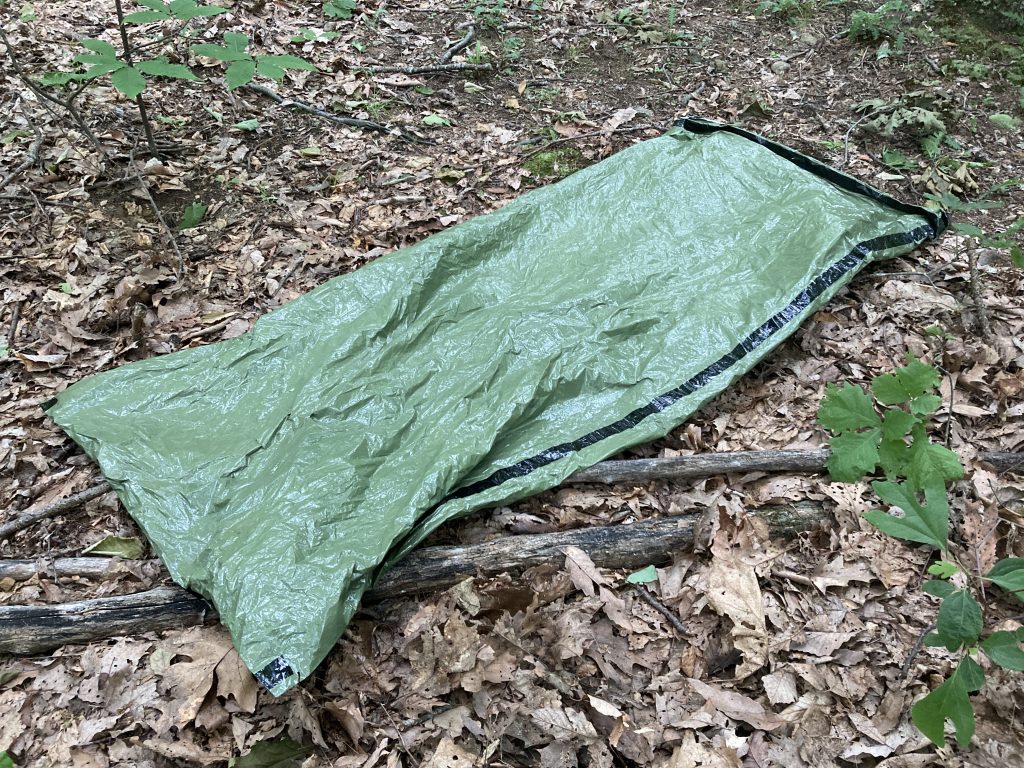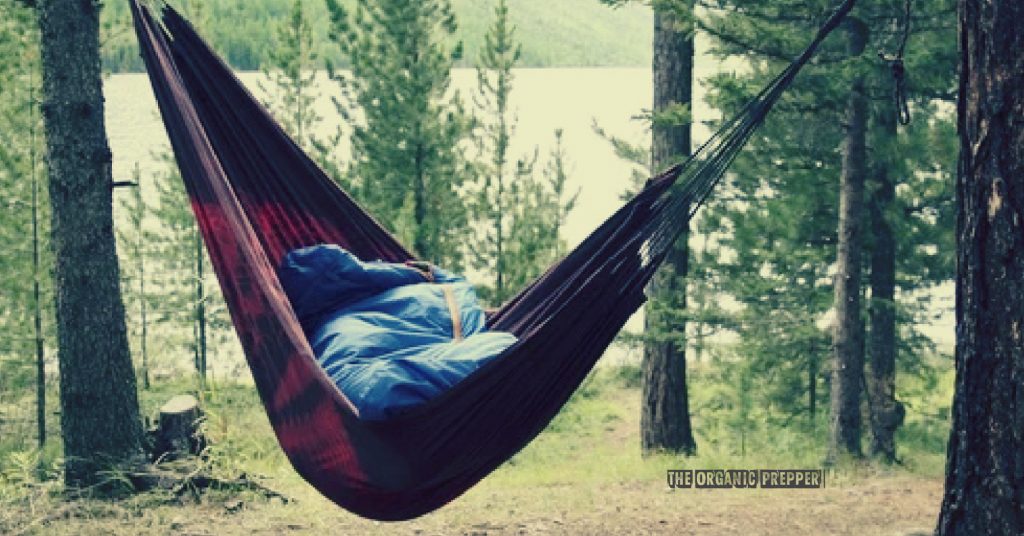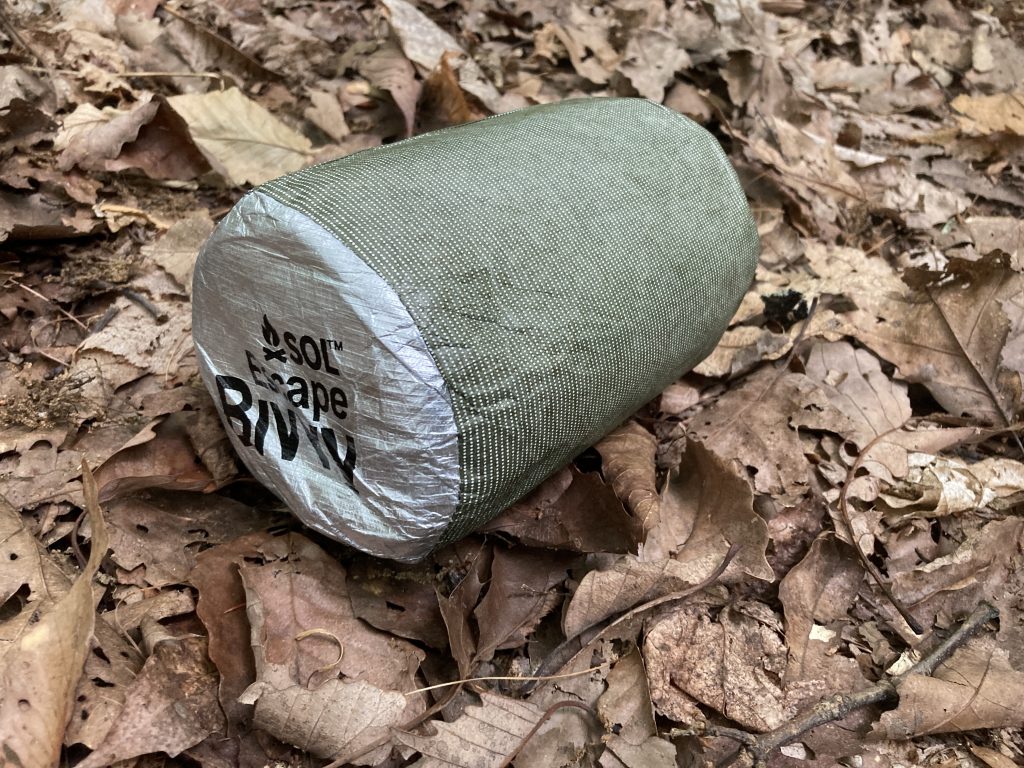If you're new here, you may want to subscribe to my RSS feed. Thanks for visiting!
By the author of The Faithful Prepper, The Prepper’s Guide to Post-Disaster Communications, and Zombie Choices.
I just got back from another night out in the woods, testing some emergency sleeping bags. I’ve used mylar space blankets in the woods before and can verify that they do actually work. One particular backpacking trip that found me shivering in the cold out alone in the mountains was rescued via the little mylar space blanket that I’d just so happened to tow along with me.
But I wanted to test something a bit more refined than that.
There are plenty of “durable” emergency sleeping bags out on the market, and I wanted to see if they were actually worth the money. So, I picked up an SOL Escape Bivvy and a Tact Bivvy 2.0 Heat Echo to test out in the mountains.
A friend and I spent one night out in the mountains testing these bags, sleeping in hammocks without underquilts. Daytime temperatures were in the upper 60s, and the humidity was 50%. Nighttime temperatures didn’t really drop until midnight when things cooled off drastically.
That’s the one thing that many people don’t realize about sleeping out in the mountains. It doesn’t matter how hot things are in the daytime. As the sun disappears, things quickly get cold.
I used the SOL Escape Bivvy. The Yankee used the Tact Bivvy 2.0 Heat Echo. I say that because it matters. When you take an indigenous Southerner and a variant of the abominable snowman out into the woods, they’re not going to have the same response to cold. The Southerner gets cold easier (in addition to possessing the correct plural version of ‘you’ and having a rhythmic grasp of the English language that outsiders call an “accent”). The Yankee wakes up excited about how “brisk” the air is.
What were our first thoughts on the bags?
The SOL Escape Bivvy
The entire bag, when compressed, is about the size of a giant travel coffee mug. It packs down small for a “real” sleeping bag, but not small compared to other emergency sleeping bags. You can easily toss it away in a pack or in the trunk of a car without it taking up too much space.
Tact Bivvy 2.0 Heat Echo
Packed down, this thing is small. It can easily be hidden in the palm of your hand. Mylar space blankets pack down larger than this thing does.
(Need more information on emergency evacuations? Check out our free QUICKSTART Guide on the subject.)
Sleeping in the SOL Escape Bivvy
When opened, it could easily accommodate a man without feeling as if you were trapped in a spider’s web like many mummy bags out there do. The material was pleasant enough. I was worried that it was going to want to stick to my skin, with the humidity being what it was. Thankfully, it didn’t.
It’s made out of a breathable material that is supposed to keep heat in and let moisture out. I didn’t have any problem whatsoever with condensation build-up within the bag.

I did have something of an issue with staying warm, however.
Again, I’m the Southerner. To survive, we need heat and sweet tea like we need oxygen. Remove any of those three variables, and we slowly shrivel up and die.
Sleeping in the Tact Bivvy 2.0 Heat Echo
The Tact Bivvy experience was virtually the direct opposite of the SOL Escape Bivvy. For starters, when Yankee woke up, the bag was dripping wet on the inside. The Tact Bivvy advertises as trapping 90% of body heat, but apparently, it does that by also trapping 90% of moisture. (The SOL Escape Bivvy advertises as trapping 70% of body heat.)
Despite this, though, Yankee slept through the entire night ‘great,’ he stated. He didn’t wake up shivering around 2 AM as I did, so I believe him. He did have a problem with the bag sticking to his skin, however, something that I did not.

Another catch was that his bag doesn’t appear to be anywhere near as durable as the SOL Escape Bivvy. He mentioned that he felt like a Chipotle burrito inside the bag, and the material is reminiscent of that. You could probably get by for a few nights in his bag, after which the bag would start to show some serious signs of wear. It’s not the sturdiest of materials.
What was the final verdict?
Out of the two choices, I believe that the Tact Bivvy is a much better choice. For starters, it’s much cheaper ($20) than the SOL Escape Bivvy ($50). I’ve bought “real” sleeping bags in the past for the same price as the SOL variant. Secondly, the Tact Bivvy packs down way smaller than the SOL Escape. If I’m looking for some type of last-ditch sleeping bag effort, that’s what I would want – a bag that takes up virtually no space in a bag can be packed away and forgotten about, and that won’t break the bank.
The bag is actually so small, you could actually carry the Tact Bivvy in a pocket. There’s zero chance you could do that with the SOL unless you’re MC Hammer.
The SOL was more durable – I think I could easily use this for several days without causing much damage to the bag – but if it’s hard to stay warm with it in The Beautiful South, there are going to be better options out there. And that leads me to our last point.
Though I completely recognize that this is subjective, I think the Tact Bivvy does a better job of keeping people warm. Yeah, there were a lot of variables in our “study” here, but it seemed to be a better choice.
If I were looking at emergency bags that were a bit more than the traditional mylar space blanket, the Tact Bivvy is where I would turn my gaze. If you’re going to drop $50-something on a sleeping bag setup that packs down to the size of two fists put together, just go ahead and buy a Snugpak Junglepak. You’ll end up with a much better and more durable bag as a result.
But hey, you may think differently than me here. Let us know what your thoughts are in the comments below.
(Want uninterrupted access to The Organic Prepper? Check out our paid-subscription newsletter.)
About Aden
Aden Tate is a regular contributor to TheOrganicPrepper.com and TheFrugalite.com. Aden runs a micro-farm where he raises dairy goats, a pig, honeybees, meat chickens, laying chickens, tomatoes, mushrooms, and greens. Aden has four published books, The Faithful Prepper, An Arm and a Leg, The Prepper’s Guide to Post-Disaster Communications, and Zombie Choices.

















13 Responses
I’d like to see some multi- night reviews. Overnight isn’t enough for me. Never had or used any of these mylar or bivy bags. Would like to get one though.
The evil globalists are burning down your food plants to starve you are create a food crisis you better do this right now because your life depends on it
Visit…….. https://zmh87889.Blogspot.Com
I often use the sol and the usmc zippered woobie as i literally hang out in hammock in WNC at 6k ft on Balsam Mtn…
Great combo, still using the original sol, love the fact it has a zipper..
I would think the 70% body heat reflection system would be the far better choice. Given that you have to keep an air passage open (with the 90% design) so that your own perspiration doesn’t leave you dripping wet soaked by morning, that seems the worst possible choice. The difference might be less noticeable during higher temperature nights, but when the weather turns really cold at night … choosing between a dry freeze (with an open air passage) or a wet freeze (with no open air passage and you getting soaked by morning by your own perspiration) is still getting frozen either way.
Unrelated: One such bag I tried to test did not come with a 90% or 70% disclosure — but it had a different problem. With me inside … it crackled so loudly with every breath I inhaled and exhaled that the noise kept me from getting any sleep. The lesson: test well BEFORE you have a real need for the product.
–Lewis
I had to LOL at your comment about oxygen, heat, and sweat tea. I am a Yankee but lived in TX for a few years. My heart is with those people, for sure, but I’m still an unsweet tea drinking, love the brisk morning air Yankee physically.
I agree with Lewis about using [not] these in freezing weather, but one would hope that if one were in freezing weather, he/she would have the proper bag and plan on being there. These bivvys should be emergency only. I do have the Tact Bivvy in my car/E&E bag (along with a mylar blanket); but not in my BOB. I’m getting a real but compressible (a bit bigger than the size of the SOL) sleeping bag for that.
Camp on, y’all!
Good article , thank you this confirms what I have heard from others . During the bad cold front in Texas a family in Dallas area stayed warm when the temprature was -22 F outside and -11F inside using the tact bivvy 2.0.
I personaly have a waterproof bivy cover , the tact 2.0 , and micro fiber blankets , 2 @ electric handwarmers w/quadro pro solar battery… all weighs less than 3lbs . I like using layers/options. And it kept me warm in -9F during the same storm .
I carry mylar blankets and light weight throws in the vehicles. They got me through 10° in a non running vehicle. At daylight I walked to find phone service. It was fine. I haven’t invested in those specialty sleeping bags. I have 2 regular bags and a cold weather bag. All about 30 years old and still fine for me.
Currently I’m laying in a sleeping bag sun just up at a lake with tall trees in Northern AZ. Son walked to the lake to fish almost an hour ago. Grandson just walked out and is talking to a friend on his phone. I’m about to get dressed. Tosty warm. Its a beautiful 63 degrees outside. Was 53° at 2:30 when I was up. Had to stop and enjoy the stars and big trees. Home is just under 100 ft lower but all juniper Forrest or cleared land where I live. I live in NM high mountain desert so not to different than here but I’d have to drive a few miles to see tall trees.
Tomorrow we’ll drive 80 miles to spend some time with my older grandson and meet his wife and my 2 great grands. Then back to the lake. Sunday we’ll go to church with my “boyfriend” who lives here. Then a few more days of fishing and enjoying nature.
I think both of the sleeping bags you tried out are out of my price range. But it is interesting to read about how they worked out.
I can hear folks up at the camps around us. I was fishing till 10:30 pm last night. I should have walked to the lake with my son. It is good fishing. We have plenty for lunch already. I’m making Indian tacos for dinner. Anything with with Indian fry bread is always easy good eating when out camping.
Campsite is paid for a couple of days more but I’ll add more days Monday. I could wish for a mountain hike and camping but a beautiful setting and good fishing is really nice. Can’t complain.
We’ve a couple of the Tact Bivy’s in our bags along with 2 rolled Polar Fleece Throws (3′ X 5′), I grabbed from Wallymart for $5 each. Have not had to use them yet. But because I’ve used a Mylar blanket once during a storm, I’d like a bit more insulation. Yes, they’ll keep you from freezing to death, but it’s not that pleasant.
Living in Colorado, if we have to travel in the winter, I’ve always just tossed our sleeping bags in the vehicle. Rated to -30, they make a much more comfortable night, if we break down.
Mylar blankets are so inexpensive anymore, there’s a couple in the glove box.
Interesting comparison review. I view sleeping outside on the ground as an absolute emergency last resort (maybe because I’ve often been closer to actual homelessness than many who go ‘camping’ for fun – most of my life has been a struggle to avoid having to sleep outside!!) So mine are untested. But I have the generic mylar carry-in-the-crown-pocket-of-your-Tilley-hat, and to cut down on sweat, I also have a thin fleece sleeping bag liner (which actually cost about 10X the price as the bag itself, from LLBean). And a Tact Bivvy to slip outside it all. The whole thing together takes up less space than 2 pairs of socks. So in the case of need, I would wriggle into the fleece liner first, then cover that with the cheapo generic mylar bag, then use the Tact Bivvy as the top layer. Right now, they take up very little space in my compact BOB, and I hope I will never actually need to try them out.
I agree maya. Everyone will have to customize to get it right for themselves. I prefer wool, then Mylar, and to wrap it all up, a waterproof bivy shell. It seems like every survival situation, the individual complains about sleep comfort, or lack there of. Thanks for your comment.
In the past I have had to kip out and used a Mylar blanket in a Bivvy bag {plastic} , it was like sleeping in a crisp packet and I woke up soaked. I always carry in the car a light sleeping bag and Goretex Bivvy bag as well as a kip mat. The latter makes all the difference.
Useful review. Perhaps you could do another and see if adding a thin fleece inner blanket makes much of a difference? Or, some other combo, & see what works best?
As a Northerner, I found your compare & contrast of you & your friend amusing, however; as to how your friend didn’t mind sleeping wet while in the cold, I don’t get that, not at all. As long as I’m dry, -20 degrees is fine, add a bunch of water & burr-!@#-cold!
I feel these emergency blankets/sacks are great, as a compliment to other materials. In an emergency, anything that greatly reduces exposure will work, just don’t expect the best sleep of your life.